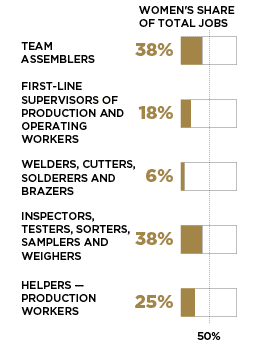Texas Women In Manufacturing
Manufacturing Overview | Printable Snapshot (PDF)
The manufacturing sector transforms materials, substances or components into new products using mechanical, physical or chemical processes. As one of the broadest sectors of the economy, manufacturing includes 21 subsectors that create a wide range of products, from food and beverages to petrochemicals and automobiles. In 2016, manufacturing contributed $218.3 billion to Texas’ economy, the second-highest contributor behind financial activities. Women account for 27 percent of the state’s 843,000 jobs in this sector.
This industry contributed
$218.3 billion
to the state GDP in 2016.
Jobs held by Texas women in this industry
229,000
These jobs generate additional business activities that ultimately support more than 609,000 jobs in other industries of the Texas economy.
Sources: BEA, Emsi, Texas Comptroller of Public Accounts
| Industry/Sector | 2017 Number of Jobs |
2017 Average Annual Earnings |
Women's Jobs | Women's Share of Total Jobs |
|---|---|---|---|---|
| Manufacturing Total | 842,513 | $92,511 | 228,750 | 27% |
| Food Manufacturing | 92,035 | $53,414 | 35,952 | 39% |
| Beverage and Tobacco Product Manufacturing | 15,889 | $73,174 | 3,741 | 24% |
| Textile Mills | 1,533 | $54,878 | 524 | 34% |
| Textile Product Mills | 5,721 | $42,131 | 2,977 | 52% |
| Apparel Manufacturing | 5,371 | $44,943 | 3,392 | 63% |
| Leather and Allied Product Manufacturing | 4,374 | $45,431 | 2,407 | 55% |
| Wood Product Manufacturing | 23,523 | $50,887 | 5,265 | 22% |
| Paper Manufacturing | 17,291 | $77,508 | 4,152 | 24% |
| Printing and Related Support Activities | 25,016 | $55,515 | 10,334 | 41% |
| Petroleum and Coal Products Manufacturing | 23,074 | $198,835 | 4,397 | 19% |
| Chemical Manufacturing | 79,192 | $137,950 | 20,065 | 25% |
| Plastics and Rubber Products Manufacturing | 37,947 | $62,912 | 11,297 | 30% |
| Nonmetallic Mineral Product Manufacturing | 38,104 | $71,528 | 6,230 | 16% |
| Primary Metal Manufacturing | 19,359 | $73,725 | 3,130 | 16% |
| Fabricated Metal Product Manufacturing | 116,807 | $71,736 | 23,572 | 20% |
| Machinery Manufacturing | 85,414 | $101,577 | 18,343 | 21% |
| Computer and Electronic Product Manufacturing | 90,280 | $150,322 | 26,893 | 30% |
| Electrical Equipment, Appliance, and Component Manufacturing | 18,475 | $96,440 | 5,144 | 28% |
| Transportation Equipment Manufacturing | 89,465 | $103,320 | 21,201 | 24% |
| Furniture and Related Product Manufacturing | 23,281 | $51,187 | 6,670 | 29% |
| Miscellaneous Manufacturing | 30,364 | $74,966 | 13,065 | 43% |
Source: Emsi
Average Monthly Earnings of Women
Earnings in manufacturing vary widely among the subsectors. The three subsectors with the highest shares of women — apparel manufacturing, textile product mills and leather and allied product manufacturing — are among the lowest-paid manufacturing fields.

| Sector | 2010 | 2016 | Earnings Growth |
|---|---|---|---|
| All Sectors | $3,067 | $3,565 | 16% |
| Manufacturing | $3,963 | $4,705 | 19% |
Source: U.S. Census Bureau
Top Occupations

| Occupation | Women’s Share Total Jobs |
|---|---|
| Team Assemblers | 38% |
| First-Line Supervisors of Production and Operating Workers | 18% |
| Welders, Cutters, Solderers and Brazers | 6% |
| Inspectors, Testers, Sorters, Samplers and Weighers | 38% |
| Helpers — Production Workers | 25% |
Source: Emsi
CONCLUSION
The manufacturing sector faces a number of challenges, most notably a shortage of trained and skilled workers. In the last few decades, industry leaders increasingly have viewed women as a solution to their skills needs. The number of women in manufacturing is growing slowly but steadily, due to various initiatives steering women into science, technology, engineering and math, but the sector is also working to change the public perception of manufacturing as a career choice and modernizing the workplace in ways that will attract younger generations.
Currently, women working in manufacturing generate additional business activities that ultimately support about 609,000 jobs in all other industries of the state economy. With time, Texas’ manufacturing sector will increasingly reap the benefits of women’s unique perspectives and leadership styles.
